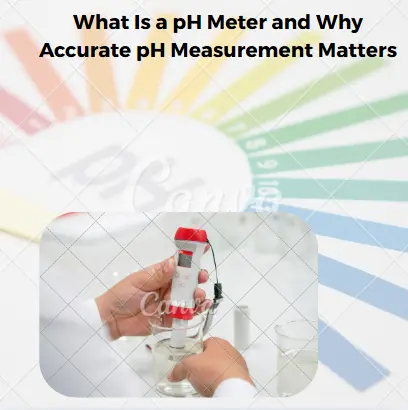PH meter is a precision instrument that convert electrochemical signals into accurate, readable measurements, enabling the monitoring and control of the critical chemical processes needed for these various applications.
In industries ranging from pharmaceuticals to agriculture, pH meters are essential tools for maintaining the integrity of chemical processes. These precision instruments convert electrochemical signals into clear, accurate readings, enabling consistent monitoring and control across various environments.
What Is pH, and Why Is It Important?
pH stands for “potential of hydrogen” and measures the concentration of hydrogen ions in a solution. The pH scale ranges from 0 to 14:
- A pH less than 7 is acidic
- A pH greater than 7 is alkaline (basic)
- A pH of 7 is neutral
Maintaining the correct pH level is vital for biological systems, industrial processes, food safety, water treatment, and many more applications.
How Does a pH Meter Work?
A complete pH measurement system includes:
- pH measuring electrode – a glass bulb that responds to hydrogen ions
- Reference electrode – maintains a constant voltage
- High-impedance meter – interprets weak millivolt signals into pH values
The pH electrode functions like a tiny ion-sensitive battery. It generates voltage based on hydrogen ion activity across its glass membrane. Because this signal is extremely weak, a high-impedance meter is required to amplify it and prevent signal loss. The result is a real-time, digital pH reading.
Types of pH Meters
There are several types of pH meters designed for different applications:
1. Benchtop pH Meters
Ideal for laboratory use, benchtop meters offer maximum precision and advanced features such as:
- Automatic Temperature Compensation (ATC)
- Multi-parameter measurements (pH, ORP, conductivity)
- Internal data logging
- Multi-point calibration
These are perfect for environments that demand high accuracy and traceability.
2. Portable pH Meters
Compact and rugged, portable pH meters are designed for fieldwork. Features often include:
- Battery operation
- Waterproof casing
- Replaceable electrodes
- ATC for accuracy in changing temperatures
Applications include environmental testing, agriculture, aquaculture, and food safety inspections.
3. Inline or Process pH Sensors
These meters are permanently installed in industrial systems for continuous pH monitoring. Built to withstand harsh conditions, they are used in:
- Wastewater treatment
- Chemical manufacturing
- Beverage and food production
These sensors integrate with controllers to automate pH adjustments and ensure regulatory compliance.
Why Use a Digital pH Meter Over Litmus Paper?
While pH test strips and litmus paper offer quick results, they lack the precision required for professional applications. Digital pH meters provide:
- High resolution (up to ±0.01 pH units)
- Consistent, repeatable readings
- Elimination of human error
- Digital displays for instant interpretation
- Data connectivity for logging and automation
These advantages are critical in industries where accuracy affects product safety, quality, and compliance.
Ensuring Accurate pH Measurements
Accuracy doesn’t just depend on the meter—it also relies on proper calibration and maintenance. Two key aspects are temperature compensation and the use of buffer solutions.
Temperature Compensation: Why It Matters
Both electrode performance and the pH of the solution are temperature-sensitive. Modern pH meters include:
- Manual temperature compensation – requires the user to input the sample temperature manually.
- Automatic temperature compensation (ATC) – uses a probe to auto-correct the pH reading in real time.
ATC is especially useful for applications with fluctuating temperatures.
Calibration Using Buffer Solutions
Regular calibration is essential. This is done with buffer solutions—stable liquids with known pH values (typically pH 4.00, 7.00, and 10.00).
Calibration tips:
- Match buffer pH and temperature to your sample range
- Use fresh solutions and rinse the electrode between each buffer
- Perform two- or three-point calibration for higher accuracy
Step-by-Step: How to Calibrate a pH Meter
- Match meter temperature to the buffer (or enable ATC)
- Set the meter to “pH” or “ATC”
- Immerse the clean electrode into a fresh pH 7.00 buffer
- Adjust the ZERO/OFFSET to 7.00
- Rinse the electrode with distilled water
- Place the electrode in a second buffer (pH 4.00 or 10.00)
- Adjust using the SLOPE or CALIBRATE controls
- Fine-tune to the exact pH value
Regular calibration ensures long-term measurement stability and reduces drift caused by aging electrodes or environmental variability.
Final Thoughts
Whether you’re in a lab, the field, or a production facility, accurate pH measurement is essential. By choosing the right type of pH meter and maintaining it correctly through calibration and temperature compensation, you ensure your processes remain stable, safe, and compliant.https://iampharmacist.com/2025/05/10/overview-of-21crf/

